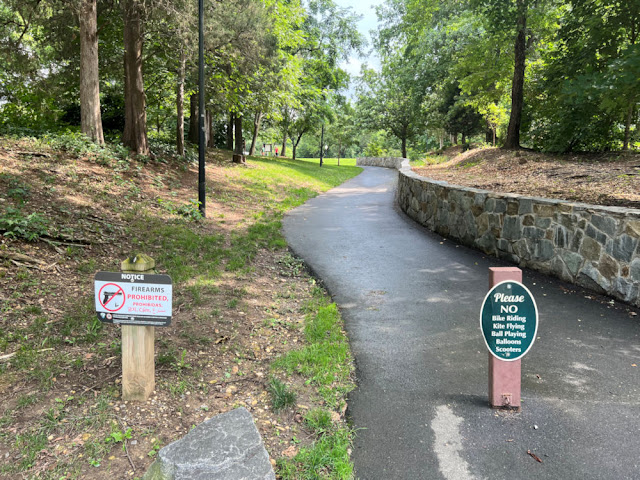Last of the photos from Green Spring Gardens for this trip at least. My previous two posts from this particular visit can be found here, here and here. We go a lot during the summer months. It is one of our favorite walking places.
I have shared these grasses before as my dear other half noticed them also, and unbeknown to each other, we had taken more or less the same photo. It is called Eastern bottle-brush grass, botanical name Elymus hystrix. Native to eastern North America. Mice eat the seeds readily. Studies are underway to examine whether bottle-brush grass can be domesticated as a food crop for livestock or potentially even for humans in the future.
Next is Blue plantain lily, also known as Hosta. Its botanical name is Hosta ventricosa. It is an herbaceous perennial native to China, and attracts hummingbirds. However, snails and slugs enjoy them too. Something I am interested in as we get a lot of shade in our garden, it prefers partial to full shade.
Blue plantain lily is low maintenance and shade-tolerant and will attract hummingbirds, as mentioned. In summer they produce lavender-colored plumes that host sweet nectar at their center. The colors are attractive to hummingbirds as they can see purple at a distance. The shape of the petals creates an enclosure at the flower's head. The hummingbird's long beak must dig through the tunnel to reach the sweet nectar. As this happens, the hummingbird gets covered with pollen which it will then spread when it leaves. Not only hummingbirds like this plant, butterflies do too. Shades of purple are easiest for butterflies to see, while hummingbirds are more attracted to red hues.
I always enjoy seeing the turtles and there were several out today. Some just skimming under the water, others on rocks like this one.
No expert here but from what I have seen online, these appear to be Painted Turtles. There is a fun page at this link that has interesting facts and also for those of you who like crafts, it shares a fun parent/child/teacher/student project, on how to paint a turtle using five rocks. Facts I found at the website: a turtle's shell is made up of 13 plates called scutes. As the turtle grows it sheds its outer layer. This means you can count the scutes rings in the same way that you can count tree rings, to find the turtle's age. Painted turtles can live up to 61 years.
They don't have teeth but do have horny plates that grind their food. Turtles hibernate under water the whole winter and hold their breath the entire time. The Painted Turtle (Chrysemys picta) gets its name from its appearance. Its skin color looks as though an artist painted it on. It is part of the American pond turtle family, Emydidae.
It is the most common turtle in North America, found in many ponds, marshes and water's edges. Like other American pond turtles, the Painted turtle loves swimming in the water and basking in the sun. The female can lay 6 to 20 eggs at a time, and those groups of eggs are called clutches. This website will tell you about the different kinds of turtles you can find in the States.
Now back to the plants I saw. I have seen this one several times over the years, and have probably mentioned it many times (other plants and flowers too no doubt). It is the Common buttonbush, also known by a lot of other names. Case in point, Button-ball, Button-willow, Button bush, Globe-flowered bush, Honey balls, Little snowballs, Swamp globeflower, White pond dogwood, Honey-bells, Riverbush and Buckbrush. Its botanical name is Cephalanthus occidentalis.
It is a multi-stemmed deciduous shrub that grows 6 to 12 feet tall and 4 feet to 7 feet wide. Grown as an ornamental for its unusual flowers, the common buttonbush can attract more than two dozen species of wild birds, including water and shore birds. Some of the birds it draws are robins, kingbirds and towhees. In the summer its spherical flowers are frequently visited by hummingbirds, as well as polinating insects, like the one below.
In the Fall the shrub produces round nutlets which are particularly enjoyed by wild ducks. Because they stay around well into winter, they are an important food source for other birds as well. The Common buttonbush is used for shelter and nesting by wood ducks and other waterfowl. Buttonbush plants are named for their fragrant white spherical flowers. Since it is one of the most common plants in the genus, it is called the common buttonbush.
Another white bloom is from the Bottlebrush buckeye, also known as Dwarf horse chestnut or Dwarf buckeye. Its botanical name is Aesculus parviflora. It grows deep red, tubular flowers that hummingbirds love to feed upon for their nectar. The seed pods also produce protein-rich seed that several types of birds consume for food.
Quite a hardy plant and my brown thumbs would do very well with this one. It grows in shade to part shade and does very well in shady spots.
I enjoy everything I see at the garden, but I was particularly interested in the lotus. It is an Indian Lotus and other names are Bean of India, Sacred Lotus and Red Lily. Its botanical name is Nelumbo nucifera.
Each blossom consists of approximately 15 petals. I more often than not rely on my plant app, Picture This. An interesting fact I read was that the Indian Lotus can live as long as one thousand years. These plants can go into stasis and then revive. Seeds from the Indian Lotus can remain viable for over a thousand years as well.
This plant is important for religious ceremonies, water treatment, crop rotation and historically, human consumption.
It is super easy to take care of, with resistance to almost all pests and diseases.
A poem that I would not have associated with its poet, but am happy to do so, was written by Edgar Allan Poe.
“And the Nelumbo bud that floats for ever
With Indian Cupid down the holy river.
Fair flowers, and fairy, to whose care is given
To bear the Goddess' song, in odors, up to Heaven.”
I am always on the look-out for birds. The smaller ones are elusive. I have seen a Great Blue Heron here, though not for a very long time. There have been ducks.
I can always count on the Canada Goose.
This one was on its own and, as you can see, was next to the lotus. Canada Geese are the largest type of goose. Females lay between 2 to 9 eggs and both parents are involved with hatching the eggs. However, the female invests more time in the incubation process. At this link you can read lots more information about them.
They are very cooperative when taking photos, and hang around long enough for me to take several. Such a good goose! I didn't see a mate today.
Most every time, my photos are shared in order they were taken, so I am back to plants and trees. This tree is called River Birch. I love its bark!
Fortunately there was an ID marker at its base. It read, "Betula nigra Heritage ('Cully'). (Species native to Virginia). Heritage River Birch." Later I read that it is also known as Water Birch, Black birch and Swamp birch.
It grows between 40 to 70 feet high. It is usually planted in threes to make a stronger visual impact, to restrict their growing space and keep them at a manageable size. Also, to give them natural protection.
The black streaks on its trunk are called lenticels, and their function is to enable the exchange of gases between the tree and the air. River birch is a strong but knotty wood. It is sometimes used to make woodenware and furniture, but it is not usually used for commercial lumber. Native Americans would boil the sap to make a sweetener and would even eat the inner bark when food was scarce. River birch is also a food source for many wild birds and even deer.

It makes a lovely shade tree, and its leaves turn yellow in the Fall. Shade-loving plants like ferns are a great choice for underplanting this birch. Underplanting as used here means to plant or cultivate the ground around a tall plant/tree with smaller plants. This info is for those who don't do a lot of gardening, and even at my age I am still learning. More information can be found at this website. I would love to plant one in the spot where we had to have a tree taken down, but it would grow far too big for the little patch we need to put it in, even with pruning. We would need a much larger garden. We are still searching for the perfect tree. As it will be a mid-planting between our home and our neighbors, even though it would be on our side of the property line, we have to consider them too.
We have finished our walk around the two ponds and made our way to the top where our car is parked. It has been another wonderful walk.

















































